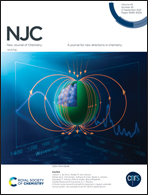Construction of a novel 2D–2D heterojunction by coupling a covalent organic framework and In2S3 for photocatalytic removal of organic pollutants with high efficiency†
Abstract
Covalent organic frameworks (COFs) as an emerging class of porous crystalline material have shown promising visible-light-driven hydrogen evolution activity. However, they have a high recombination ratio of charge carriers and usually use a noble metal as the co-catalyst to realize a high catalytic efficiency. Thus, how to effectively suppress the recombination of the charge carriers to gain a high catalytic efficiency without using a noble metal is a great challenge. Moreover, their potential for the removal of organic pollutants remains hardly explored. In this work, for the first time, TpPa-1 COF was coupled with an inorganic narrow-band gap semiconductor In2S3 to form a novel 2D–2D heterojunction by a facile hydrothermal method. The formed heterojunction with a well-matched band position can effectively accelerate the charge transfer, prevent the recombination of charge carriers and improve the light absorption as well as specific surface area. Furthermore, the constructed 2D–2D layered structure can increase the contact area with intimate interface contact which further facilitates the charge mobility and transfer in the interface. The results of photocatalytic degradation of a high concentration of TC and RhB showed that the TC and RhB degradation rates with the 2D–2D heterojunction are 150 and 41 times higher than pure COF, and 2 and 3.4 times higher than pure In2S3, respectively. This study presents an effective strategy to modify the photocatalytic properties of COFs through artfully integrating COFs with band-matched inorganic semiconductor materials into a hybrid with a 2D–2D interface.



 Please wait while we load your content...
Please wait while we load your content...